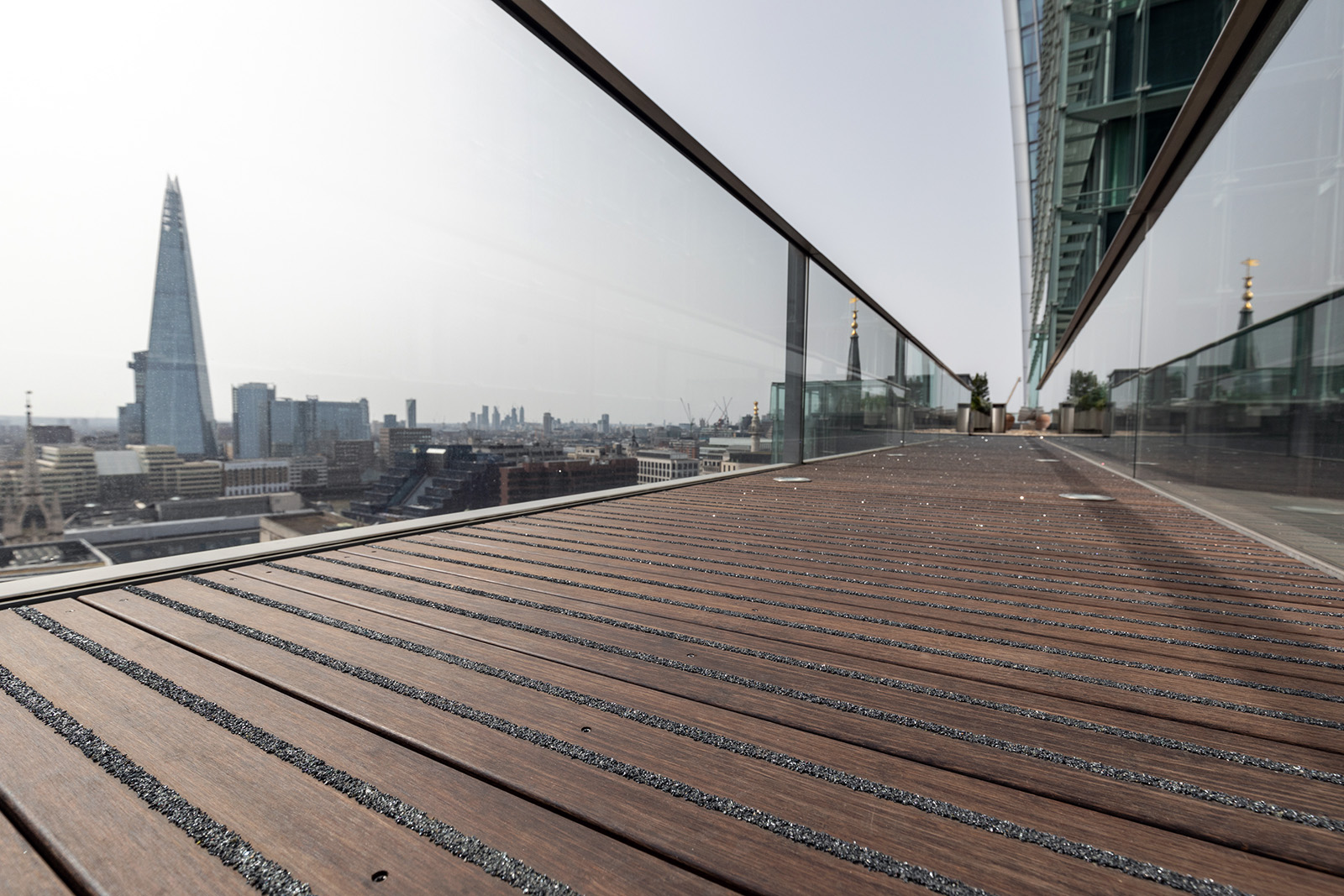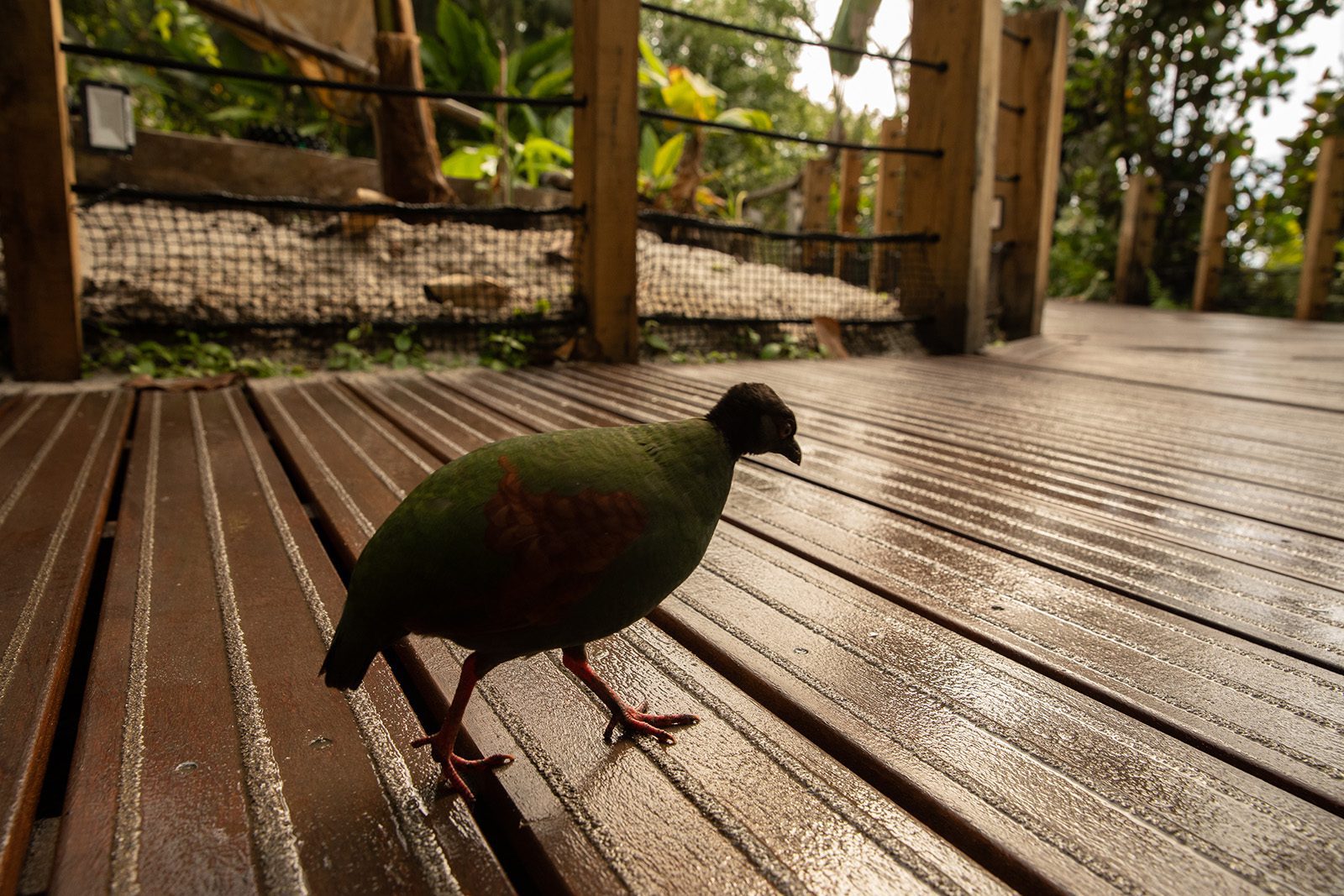Gripsure non-slip decking is designed to be a safe-yet-attractive decking solution for any application, from large home projects to commercial premises and outdoor spaces.
Non-Slip Decking and Anti-Slip Decking
Choosing the right Non-slip Decking Supplier
With almost 20 years of supplying anti-slip decking, we’re proud to bring you the widest range of non-slip decking boards that come with the highest slip ratings on the market.
Whether it’s a large public space in need of safe and reliable access all year round, or an architectural build that can benefit from the aesthetic and functional value of high-quality non-slip decking boards, you can rely on our products to provide you with a complete decking solution.
How to Choose the Right Non-Slip Decking
Choosing the right non-slip decking for your project depends on a variety of factors. The most important of these factors is the type of wood: whether that is softwood, hardwood, or bamboo.
Softwood decking offers an affordable-yet-reliable option, and the lighter coloured tones of softwoods can complement a surrounding natural environment.
Hardwood or bamboo decking, on the other hand, serves as a premium option offering extreme durability and a beautiful finish for larger architectural projects or high-traffic areas. Bamboo decking is also a great choice if you want to lower your impact on the environment.
We supply a variety of non-slip decking and products including:

To help you choose the right decking for your project, we’ve included a list of the top things you need to consider when selecting your decking boards:
Durability and Slip Resistance
Occasionally, a project will require a specific level of durability or slip resistance. Some of our more application specific options of non-slip decking provide the perfect solutions for these projects and uses.
For example, our Boardwalk Heritage Non-slip Decking is a popular choice for high profile projects and is perfect for woodland ramps, disability access points, or walkways that require an extra bit of slip resistance.
Reducing Algae, Mould, and Mildew Growth
Another great product that we’ve specifically engineered for increased functionality is our Aquadeck Non-slip Decking. Compared to traditional rubber infill which can retain water and promote algae, mould, and mildew growth. This unique type of infill is designed to permeate and drain through the decking board which eliminates trapped water.
Choosing the Right Hardwood Non-Slip Decking
When choosing hardwood decking, your decision will likely be based around the visual aesthetics of the timber as they all have a similar level of durability. For example, Yellow Balau Non-slip Decking and Cumaru Non-slip Decking have a comparable durability rating and expected service life, offering different choices of visual aesthetic and weathering. On the other hand French Oak Non-Slip Decking has quite a unique look for hardwood as it is very light in colour, with a slightly lower durability compared to Yellow Balau and Cumaru Decking.
Rot and Decay Resistance
Protecting your decking from the elements and reducing rot and decay in the wood is important to safeguard the longevity and durability of your decking boards. Our Thermowood Ash Non-Slip Decking has gone through a thermal modification procedure that changes the properties of the timber, making it resistant to rot and decay.
For more treated and modified timber options like Accoya Decking and Kebony Decking, please view our range of Modified Timber Decking. To explore more options of non-slip decking, please browse our complete range of non-slip decking boards.

The Importance of Non-Slip Ratings
Non-slip decking ratings are an extremely important consideration when choosing the right anti-slip decking for a project. Pendulum Test Value (PTV) is a metric used to measure the effectiveness of non-slip decking boards. This value informs the level of friction of the boards, allowing them to comply with the BS 7976 guidance and the UK Slip Resistance Group’s guidelines which apply to all surfaces.
The range of PTVs is from 0 to 65+, with higher numbers offering greater slip resistance. At Gripsure, we’re proud to have the most effective non-slip ratings on the market. We even offer a unique 15-year guarantee that our boards won’t fall under a PTV of 55. This means that the potential of slipping on one of our non-slip decking boards is extremely low, even after long-term use in high-traffic areas.
The decking boards supplied for The Eden Project are a testament to this as even though the boards are located in extremely high-traffic areas, they have managed to maintain a safe level of slip resistance even after 15 years of being in use.
Although the slip resistance of decking boards will drop over time, our boards achieve a very high initial PTV, so this drop still means that our products are above the minimum requirement for a low slip-potential surface while surpassing the initial PTV of every composite board on the market.
For more information on our previous work using non-slip decking, please explore our non-slip decking projects. To find out more about why non-slip decking is important, please read our guide on what makes decking slippery and how to avoid it.
Frequently Asked Questions About Non-Slip Decking
In order to help you choose the right anti-slip timber decking, we’ve answered some of the most frequently asked questions.
-
What’s the difference between hardwood and softwood non-slip decking?
As is the case with other types of decking, the difference between hardwood and softwood decking is the type of wood used. Softwood decking uses, as you would expect, softer wood. These types of wood grow quicker than hardwoods, making them more affordable at the cost of lower durability. Softwood options like our Home Non-slip Decking, which uses Northern European Redwood Pine, are typically cheaper compared to hardwood options.
-
How safe is non-slip decking and is it any good?
This will depend on the slip rating of the inserts used on the decking boards. At Gripsure, we pride ourselves on having the highest anti-slip ratings on the market. We offer a unique 15-year guarantee that our boards won’t fall under a PTV of 55. This means your decking boards will have a very low potential for slipping, making them safe and reliable even after long-term use in busy areas.
Learn more about how to make your garden safe through the autumn and winter >
-
Is non-slip timber decking better than non-slip composite decking?
Generally, composite non-slip decking has a much lower slip rating than timber as wood decking boards tend to offer more friction. Timber non-slip decking also typically comes with higher quality inserts which provide superior slip resistance. As mentioned above, our decking boards exceed the slip resistance of all composite decking boards available on the market, even after many years of prolonged use.
Learn more about whether you should use composite decking in your garden >
-
What can I put on my decking to make it non-slip?
The most effective long-term solution for making existing decking boards non-slip is to use Retrofit Inserts. These anti-slip decking inserts offer you an easy, quick and reliable way to significantly increase the slip resistance of your decking boards without replacing them or using damaging chemical-based products.